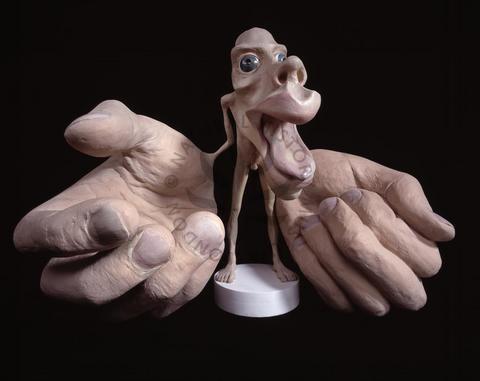There are many companies and individuals trying to build similar devices, with various strengths and weakness, at various price-points, and with varying degrees of openness. As we see the situation, most of these efforts have been directed at one (or perhaps a few) specific industries and applications. Ultimately, this can only lead to fragmentation and mutual incompatibilities between different manufacturers and applications.
It is the goal of this project to provide an affordable, general platform on which all other gloves can be emulated, and that does not require a host computer to be used as a high-level tool for sensing things in the environment that we ordinarilly cannot.
Additionally, the potential for accelerating human communication with computers has not yet received the attention that the designer feels it is due.
Perspective
The following model depicts a human form resized to be proportionate to the amount of brain devoted to control of those muscles.

This diagram gives the same information, but arranged by location on the strip of cortical surface devoted to motor control.

This is an astounding ratio, and represents a large fraction of neural material that we funnel into computer input peripherals that are ill-suited for the amount of brain that we could be using to control them.
The fact that we have thumbs and walk upright has allowed our hands to become specialized for environmental manipulation. As a tool-using species, we owe our survival to our hands; the machinery by which we remake the world as we see fit.
As the generations of tool-users roll past, we can see the extent to which we ourselves have been remade by our chosen tools. A mutually reinforcing relationship between mind and hand has doubtless been a core force responsible for the unprecedented success of our species in the face of a changing world. By this author’s reckoning, only the arthropods even come close to our adaptive capacity.
The computer has only begun to remake us. But in order to move forward with the best efficiency, we can’t remain as constrained as we are by the present state of input peripherals.
Example applications envisioned by the designer
These fall into two broad categories: Host and host-free.
Host mode functionality depends on a connection to a host computer. In this mode, the glove is seen as a bluetooth device by the host.
In host-free mode, the resources on the glove alone are sufficient to meet the demands of the application. The bluetooth radio can also act as a host and control other peripherals.
The following host-free applications are being considered…
- Sign-language capture (parsing may require a host, but capture can be host-free)
- Measureing range-of-motion of an injured hand
- As an electric current and frequency sensor (AC wiring diagnosis)
- A thermograph (via the thermopile sensor)
- As a magnet-mapper (using the onboard magnetometers to build a 3d-map of a magnetic field).
- Measuring internal structure dimensions by tracing the interior edges
- Locating hidden magnets and current-carrying wires
- Intuitive UAV control
- Infrared remote control
On-board hardware cryptographic acceleration will allow a suite of applications that depend on cryptography such as…
- Cryptocurrency wallets with de facto biometric security
- Biometric authentication via bluetooth MAC and gesture
The following additional host-dependent applications are being considered…
- Sign-language capture and parsing
- As a teaching aid for fields where precise hand usage is demanded, such as…
- Music using a traditional instrument
- Firearm marksmanship (differentiating between recoil and shot anticipation)
- Sign language
- As a MIDI or OSC device
- 3D modeling via 3D goggles (SolidWorks, Blender, Maya3D, etc)
- Vidjya games
How
There is a list of use-cases that we plan to write applications for. But the open-source world has a wonderful property in that individuals within it frequently do strange and beautiful things that you couldn’t have imagined, using only the tools that are already at your disposal.
We believe that we have designed a hardware platform with sufficient generality to allow for novel applications to be developed against common core hardware at costs approaching those of a high-end desktop mouse. If additional capabilities are required, the expansions developed for one purpose could be easily reused for another.
Some suggested hardware expansions that would be natural additions…
- Additional sensors (GPS)
- Haptic feedback peripherals
- Additional comm modules (wifi, GSM, NFC, etc)
Other more exotic ideas might be along the lines of…
- A micro laser projector
- A laser target painter (for directing an autonomous UAV, suppose)
Connectivity
USB will be retained as an option for connecting to a host, but considering the wearable nature of the device, this will likely be relegated to developer usage and charging.
The preferred connection mode for host communication is bluetooth. The bluetooth module can be run in host or peripheral mode.

